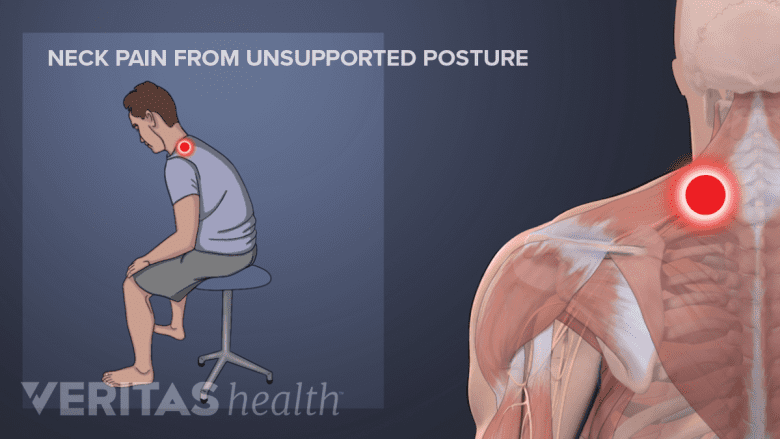If pain and symptoms from cervical degenerative disc disease intensify, steps can be taken to help alleviate the problem. The first steps are usually self-care and/or non-surgical treatment options, and typically these will effectively manage the pain.
In rare cases when pain and symptoms persist or worsen despite several months of treatment, or if spinal cord health is at stake, surgery may be considered.
In This Article:
- Cervical Degenerative Disc Disease
- Cervical Degenerative Disc Disease Symptoms and Diagnosis
- How Cervical Degenerative Disc Disease Causes Pain and Other Symptoms
- Cervical Degenerative Disc Disease Treatment Options
- Cervical Degenerative Disc Disease Video
Non-Surgical Treatment Options
For neck pain stemming from cervical degenerative disc disease, a doctor will typically recommend one or a combination of the following treatment options:
Rest or lifestyle modification

Maintaining a supported posture reduces strain on the neck.
Certain activities might be more painful for the neck, such as craning the neck forward to look at the computer monitor or a specific swimming stroke. Refraining from or modifying certain activities for a few days or weeks will usually reduce the pain. In addition, maintaining strong posture (instead of slouching while sitting or flexing the neck forward while driving, looking at a cell phone, etc) is recommended. Eating healthy, staying hydrated, and quitting smoking are also all beneficial for disc health.
Pain management with medication or injections

Cervical epidural steroid injections reduce inflammation and control painful symptoms.
Over-the-counter pain relievers, such as acetaminophen (such as Tylenol), ibuprofen (such as Advil, Motrin), or others might be beneficial. If not, a stronger pain medication, such as oral steroids or muscle relaxants may be prescribed. Other options could include an injection that delivers medication directly to a certain part of the neck, such as a cervical epidural steroid injection or a cervical facet injection.
Ice and/or heat therapy
Some people find pain relief by applying an ice pack or a heated gel pack to the uncomfortable part of the neck.
Exercise and/or physical therapy
Neck exercises boost strength and flexibility, reducing the risk of pain.
Most non-surgical treatment programs for neck pain will include some form of exercise and stretching. A physical therapist or other trained health professional can prescribe an exercise and stretching regimen that meets the specific needs of the patient. In general, increasing strength and flexibility in the neck can lower the risk for pain.
See Physical Therapy for Neck Pain Relief
Manual manipulation
The cervical spine can be manually adjusted by a chiropractor or other qualified health professional in an effort to improve range of motion and/or reduce pain. Depending on the person’s symptoms, a physical exam and/or imaging study should be done prior to manual manipulation of the neck.
See Chiropractic Manipulation for the Cervical Spine
The above list does not include all treatment options for pain related to cervical degenerative disc disease. Many other options could be considered as well, such as massage therapy, electrical stimulation TENS unit, bracing, or acupuncture.
Surgery for Cervical Degenerative Disc Disease
Surgery to treat cervical degenerative disc disease is generally considered in two cases:
- Neurological symptoms are present, such as persistent arm numbness and/or weakness, or trouble with walking or bowel control. If neurological symptoms are caused by cervical DDD there is a risk of permanent nerve damage, and surgery may be recommended to alleviate pressure on the nerve.
- Chronic pain is severe and not adequately relieved after at least six months of non-surgical treatments, and daily activities become difficult. Better surgical results are predicted for patients with chronic pain coupled with other findings such as cervical instability, and/or radiculopathy.
The two most common types of surgery for cervical degenerative disc disease are:
Anterior cervical discectomy and fusion (ACDF)
This procedure is done through the front of the neck and involves removing the problematic disc, decompression of the nerve root, and insertion of a bone graft or a metal cage device to help maintain or reestablish the normal height of the disc space.
See ACDF: Anterior Cervical Discectomy and Fusion
If there are neurological symptoms from spinal cord compression, the surgery may also include removing part of a vertebra or widening the spinal canal to give more space for the spinal cord before the fusion is done.
Cervical artificial disc replacement
This surgery involves removing the problematic disc and replacing it with an artificial disc. The goal of this surgery is to preserve motion at that spinal level. Cervical artificial disc replacement results may be better in patients with minimal arthritic changes to the posterior facets.
See Artificial Disc Vs. Anterior Cervical Discectomy and Fusion
For relieving pressure on nerve roots and/or the spinal cord and thus reducing neurological symptoms like arm pain or weakness, neck surgery tends to have a good success rate—some estimates in literature are between 80% and 90%.1Rhee JM, Yoon T, Riew KD. Cervical radiculopathy. J Am Acad Orthop Surg. 2007; 15(8): 486-94.
However, neck surgery has a lower success rate for relieving pain that is only in the neck itself.1Rhee JM, Yoon T, Riew KD. Cervical radiculopathy. J Am Acad Orthop Surg. 2007; 15(8): 486-94. If the disc space cannot be verified as the probable pain generator, it may be reasonable to avoid surgery and keep trying various types of non-surgical care to manage the pain.
- 1 Rhee JM, Yoon T, Riew KD. Cervical radiculopathy. J Am Acad Orthop Surg. 2007; 15(8): 486-94.

